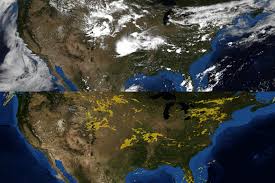Source: newatlas.com
One of the most difficult challenges for artificial intelligence systems is predicting the weather – with an almost infinite number of variables to assess and model. But Google says its AI is making progress in the accuracy of its “nowcasts.”
Nowcasting is forecasting the weather in the very short term, over the next one or two hours. While a quick glance out of the window might give you some idea, knowing exactly when rain is about to start or stop (for example) can be incredibly useful for event planning, farming, disaster prevention and many other purposes.
Google has applied deep learning techniques, modeled on the neural networks of the human brain, to produce improved nowcasts for small areas (one sq km or 0.39 sq mi) over the course of an hour.
The new system, presented in a paper that has not yet been peer reviewed, is a significant step forward from existing prediction models, Google says. It can make accurate predictions in minutes rather than hours, which is much more useful when you want to know what the weather is going to do in the short-term.
That speed increase is achieved by ditching the heavy lifting of computationally intensive physics models, and replacing it with neural networks that are trained on historical data.
“A significant advantage of machine learning is that inference is computationally cheap given an already-trained model, allowing forecasts that are nearly instantaneous and in the native high resolution of the input data,” writes Jason Hickey, a Senior Software Engineer at Google Research, in a blog post.
Google’s AI nowcasts proved more accurate than three existing prediction techniques they were compared with, though the roles were reversed for forecasts more than six hours ahead – for now, this type of artificial intelligence processing is best suited for making short-term predictions in weather patterns.
AI also excels at chewing through – and making sense of – large amounts of data. The National Oceanic and Atmospheric Administration (NOAA) now collects nearly 100 terabytes of data per day from radar, satellites, weather stations and other sources.
One of the tricks Google’s system pulls is treating nowcasting as a computer vision problem, rather than trying to model real-world physics. Radar images are collated and analyzed using convolutional neural networks or CNNs – the same layered networks used to recognize objects in images and to interpret natural speech.
These CNNs are particularly good at achieving fast results with a high level of accuracy, as long as they’ve had enough training data, and the early signs are they could be very useful for nowcasting as well.
On a broader scale, knowing how weather conditions are shifting in real time is going to be crucial in assessing how climate change continues to impact the planet, and it seems AI is up to the challenge.
“As weather patterns are altered by climate change, and as the frequency of extreme weather events increases, it becomes more important to provide actionable predictions at high spatial and temporal resolutions,” write Google’s researchers in their paper.


